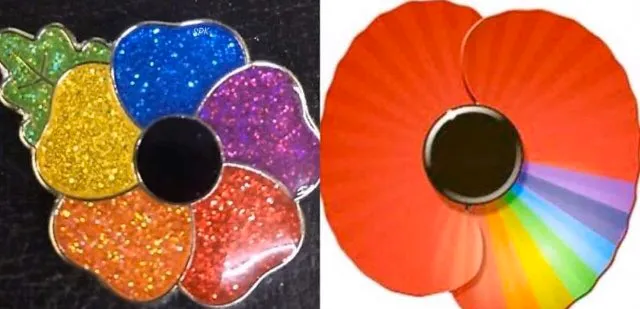13 things you really need to know about the ‘rainbow poppy’

‘Rainbow poppies’ that aren’t actually a thing have cultivated controversy. (Twitter)
Discourse surrounding the ‘rainbow poppy’ – also known as the LGBT+ poppy – has been dominating Twitter in the last few days, so we thought we’d set the record straight once and for all.
1. OK, first things first, can I buy the LGBT+ or rainbow poppy?
No.
2. But wait, doesn’t the LGBT+ poppy only show respect for queer people and nobody else?
No.
3. So… is it an LGBT+ poppy?
No. It’s glittery, it’s multicoloured, but it’s not affiliated with the LGBT+ community.
4. What is it then?
A badge.
5. Where did it come from?
A bunch of Twitter users somehow found an eBay listing of a ‘rainbow glittery poppy style badge’.

Despite it being the size of a 50 pence coin, it’s induced a huge amount of fury. The seller even pleaded on the product page to stop sending them “vile” messages.
The seller has listed the product at least twice, selling three pairs of the badges under a title that did include “LGBT+” and “gay Pride” in the title, according to a previous listing from September.
However, the seller did not specify in what way, other than its rainbow colouration, what the poppy symbolised and how it connected to the community. When re-listed in November, the terms were removed and the item re-named and sold at least 83 badges this time around.
Nevertheless, the iteration of the poppy fanning the flames of people’s fury is no longer linked to the LGBT+ community.
6. Is the rainbow poppy still for sale?
Nope.
The seller removed the item alongside all their other wares, it appears, sometime after the bubbling backlash.
Moreover, they specified that the profit from the badge did go to “charity”.
7. So you’re telling me it’s not the LGBT+ community hijacking the red poppy?
Could not be farther from the truth.
8. Hold up, what about that other poppy design, the one with the LGBT+ Pride flag on the petal?
This design does mean something to the community, but once again, you can’t buy it.

In other words, it’s not a thing.
9. Who made the rainbow poppy?
Back in 2016, LGBT+ poet Trudy Howson posted a picture of the traditional red remembrance day poppy on their website.
Yet, it appeared that it never went into production neither was it sold, and simply exists as a standalone picture.
10. Colour specifics aside, what does the rainbow poppy signify?
Above the picture of the poppy, the poet wrote: “The rainbow poppy is a campaign I’m running to bring attention to the brave soldiers who died for our country during WWI at a time when their sexuality was still criminalised.”

So, this design of the poppy did not commemorate LGBT+ people involved in the war and them only.
Instead, it respected everyone as well as raising the visibility of queer soldiers whose activity is so often left out of the history books.
11. LGBT+ people existed in the war?
Yes.
A notable example is Alan Turing, a gay codebreaker who cracked the German enigma codes who is widely believed to have helped end the Second World War earlier than expected, saving millions of lives.

He was later chemically castrated after being convicted of ‘gross indecency’ in 1952 for having sex with a man.
Or the poets and soldiers Wilfred Owen and Siegfried Sassoon.
The two documented the torment of both the battle itself and sustaining outlawed love in the trenches of the First World War.
And an uncountable amount of LGBT+ soldiers served throughout these times of conflict who were unable to come out.
Mainly because being queer was illegal due to the legislation at the time in many countries.
12. What has the Royal British Legion, the makers of the official red poppies, had to say about this?
Amid swirling speculation that the rainbow poppies are a thing, the Royal British Legion was forced to clarify that, yes, they are not a thing.
In a tweet today, the charity clarified that the above poppies are not affiliated with them and are not in production.
Hi, Nigel. Yes, we can confirm we have not altered our red two petal poppy or issued a rainbow poppy. The red poppy recognises the service and sacrifice of people from all communities who have served with the British Armed Forces including those from the LGBTQ+ community.
— Royal British Legion (@PoppyLegion) November 8, 2019
The RBL reiterated that the red poppies remember and pay respect to all the people who lost their lives due to conflict.
But, as a number of LGBT+ activists have said, as much as an ‘LGBT+ poppy’ isn’t something the community has called for, they have welcomed increased visibility for queer people’s involvement in the two Great Wars and beyond.
Alongside discussion about how the involvement of such a marginalised group of people has been minimised for decades.
They deserve to be remembered, too.
13. So, not only are these poppies not being sold, but they aren’t for the LGBT+ community and nobody else, they aren’t official campaigns which queer people rallied for and you’ve had to do an entire explainer on this to clarify it all?
Yes.
How did this story make you feel?

